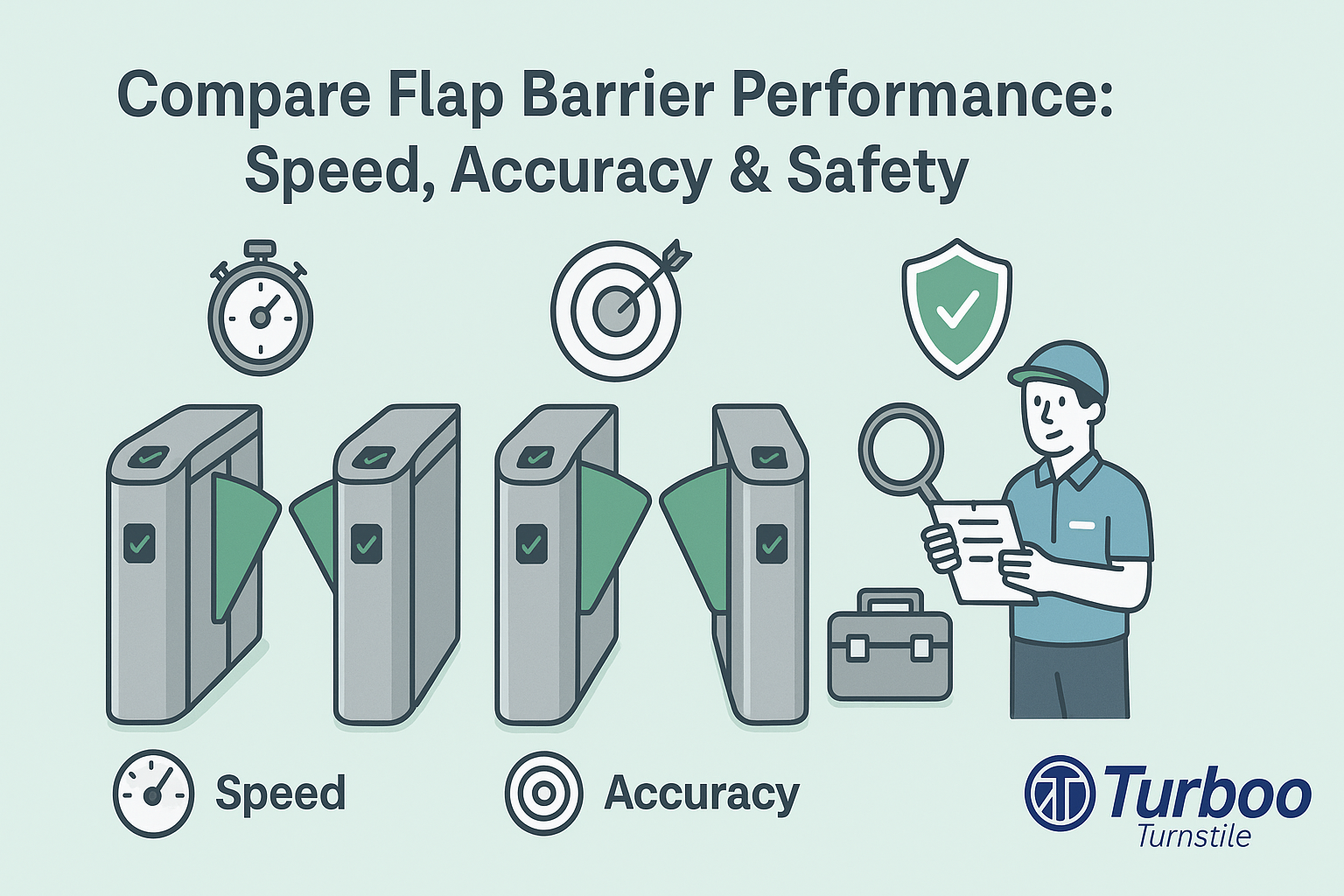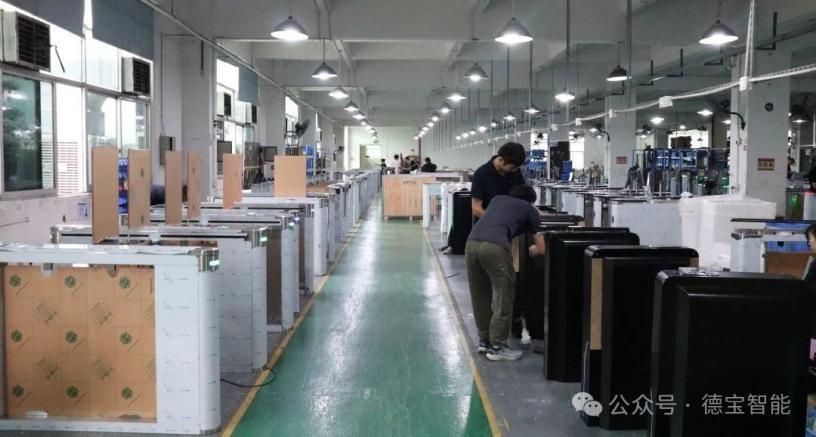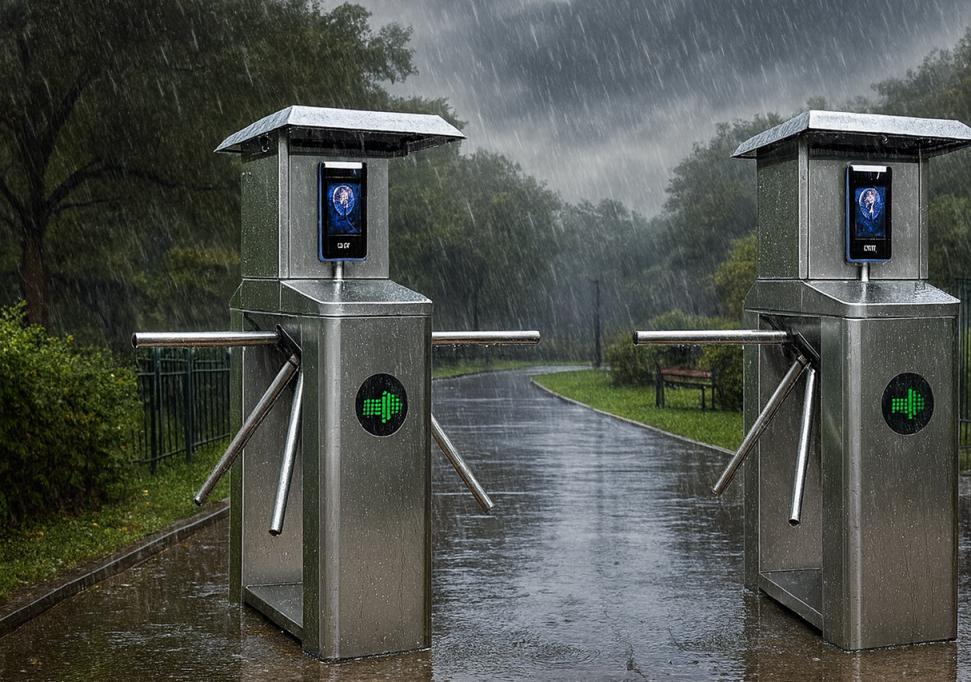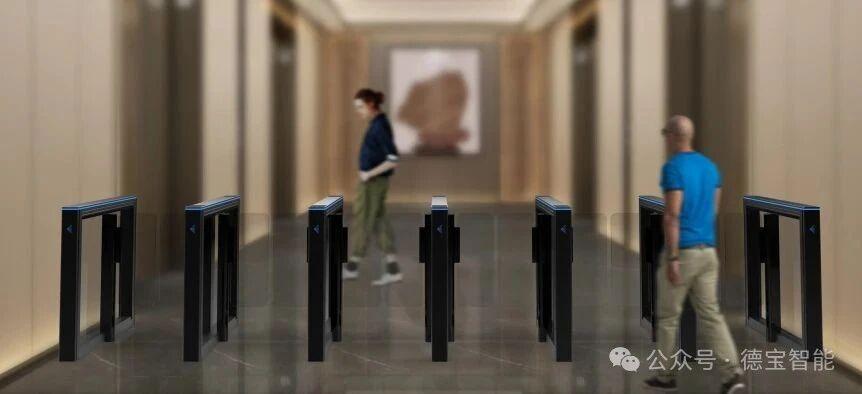Compare Flap Barrier Performance: Speed, Accuracy & Safety


Flap barriers are becoming essential for managing access control and ensuring security in busy environments such as airports, corporate offices, and stadiums. Choosing the right flap barrier system is crucial, as it directly affects security, user experience, and operational flow. When comparing flap barrier models, buyers must evaluate three primary performance metrics: speed, accuracy, and safety. These factors determine how effectively the barrier integrates into your facility’s operations.
The challenge in selecting a flap barrier lies in balancing these performance metrics. Speed impacts user throughput, accuracy ensures proper access control, and safety features protect both people and property. An imbalance in any of these areas can lead to security breaches or disrupt the flow of people, causing frustration for both users and security teams.
In this guide, we will break down how to evaluate and compare flap barriers based on their performance in terms of speed, accuracy, and safety. Understanding each of these metrics will help you make a well-informed decision, ensuring your system operates efficiently without disruptions or security concerns.
Evaluating Flap Barrier Speed
The speed of a flap barrier is one of the most critical performance aspects. It refers to how quickly the barrier opens and closes, which directly influences the flow of people in and out of a secured area. A range of factors determine the speed of a flap barrier, including the motor’s power, the design of the flap mechanism, and the environment in which the barrier is used.
For example, a barrier with a more powerful motor will typically open and close faster, but this can come at the expense of smoothness and reliability. The material and design of the flap itself can also impact how quickly the barrier operates. Faster models may be better suited for high-traffic environments where large numbers of people need to pass through quickly, while slower models might be better for more controlled settings.
When evaluating flap barrier speed, it’s essential to consider how long it takes for the system to detect a user and fully open the barrier. High-speed barriers may be ideal for areas with high foot traffic, but they must still maintain reliability and accuracy in their operation to avoid errors or accidents.
The Impact of Speed on Throughput and User Experience
Flap barrier speed has a significant impact on user throughput – the number of people that can pass through a barrier in a given time period. Faster barrier speeds generally result in higher throughput, which is especially important in high-traffic environments like airports or train stations. A barrier that opens too slowly can cause delays, leading to congestion and frustration for users.
However, speed must be balanced with other factors, such as safety and accuracy. If a barrier opens too quickly, users may not have enough time to pass through, leading to confusion and potentially triggering safety concerns. Conversely, if a barrier is too slow, it can cause unnecessary delays, especially during peak hours.
It’s essential to find the right balance between speed and user experience. The optimal speed for a flap barrier depends on the volume of users and the specific requirements of the facility. For example, barriers in office buildings may function well with moderate speeds, while systems in transportation hubs need to open and close quickly to accommodate high numbers of passengers.
Speed and Operational Flow: Finding the Balance
When assessing flap barrier speed, it’s crucial to consider more than just how quickly the barrier opens. The speed must also integrate well with the overall operational flow. Barriers that open too fast might cause users to rush, which could lead to security issues, such as users tailgating or bypassing the barrier altogether. On the other hand, barriers that open too slowly can create bottlenecks and frustration.
An ideal flap barrier system should provide smooth and efficient access without unnecessary delays or risks. Adjustable speed settings are often a great feature, as they allow the barrier to operate at a pace that matches the specific needs of the facility. This flexibility ensures that the system can adapt to different traffic conditions, ensuring that both speed and security are maintained.
Flap Barrier Accuracy: Ensuring Reliable Access Control
Accuracy is another critical factor in evaluating flap barriers. It refers to the barrier’s ability to correctly detect users and grant access based on pre-set security parameters. The sensors in the flap barrier must accurately detect when someone approaches, whether they are authorized to pass, and when to activate the barrier.
Inaccurate sensors can result in a range of issues, from unauthorized access to delays in opening or closing. For example, if the system misidentifies a legitimate user as unauthorized, it could prevent them from accessing the secured area, causing frustration. Conversely, a system that grants access to unauthorized users compromises the security of the facility.
Flap barrier accuracy is primarily influenced by the type of sensors used. Most modern flap barriers rely on infrared, photoelectric, or motion detection sensors. Each of these sensor types has its advantages and limitations, and their accuracy can vary depending on environmental factors such as lighting conditions, the angle of detection, and the user’s movement speed.
Evaluating Sensor Technology in Flap Barriers
When comparing flap barriers, it’s essential to evaluate the sensor technology used in each system. Different sensors have different levels of sensitivity, accuracy, and reliability, which can directly impact the barrier’s performance.
- Infrared Sensors: Infrared sensors work by emitting a beam of infrared light and detecting when the beam is interrupted. These sensors are commonly used for detecting the presence of a person and activating the barrier. However, they can sometimes struggle with accuracy if the light conditions are not optimal.
- Photoelectric Sensors: Photoelectric sensors detect the presence of a person based on light reflected back to the sensor. These sensors tend to offer high accuracy, but they can be sensitive to environmental factors like dust or fog, which might interfere with the signal.
- Motion Detection Sensors: Motion detection sensors use radar or ultrasonic waves to detect movement. These sensors are less sensitive to environmental factors but may struggle with detecting stationary objects or very slow movements.
Choosing the right type of sensor depends on the environment and specific security requirements. Facilities with high traffic and various lighting conditions may benefit from a combination of sensor types for more accurate and reliable performance.
Accuracy vs. Reliability: Choosing the Right Model
While accuracy is crucial, it’s also important to assess the reliability of the sensor system. Some systems may provide highly accurate readings but suffer from frequent malfunctions or failure to detect users in certain conditions. Reliability is particularly important in high-traffic areas where a malfunction could cause major disruptions or compromise security.
It’s essential to test the barrier’s sensor accuracy in real-world conditions to ensure it meets your needs. Some manufacturers offer trial periods or demonstration units, allowing you to assess the performance of the system before making a final purchase. Be sure to evaluate how well the system performs in various lighting conditions, with different user speeds, and during peak traffic periods.
Flap Barrier Safety Features
Safety is a paramount consideration when selecting a flap barrier system. A system with inadequate safety features can pose risks to users and undermine the effectiveness of the security system. Most modern flap barriers come equipped with a variety of safety mechanisms designed to protect both users and the barrier itself.
Some common safety features include:
- Anti-pinch mechanisms: These prevent the barrier flaps from pinching users or objects as they pass through.
- Anti-tailgating sensors: These detect when someone attempts to bypass the barrier without authorization, ensuring that only one person enters at a time.
- Obstacle detection: If the barrier detects an obstruction, it will automatically stop or reverse, preventing injury or damage.
These safety features not only protect users but also reduce the risk of liability for facility managers. Investing in barriers with strong safety features ensures that the system operates as intended while minimizing the risk of accidents.
Anti-Tailgating and Anti-Tampering Systems
One of the most critical safety concerns in flap barrier systems is preventing tailgating. Tailgating occurs when an unauthorized person follows a legitimate user through the access point without being detected. This poses a significant security threat, especially in high-security environments where access control is vital.
Modern flap barriers come with anti-tailgating features that detect when more than one person is attempting to pass through at the same time. These sensors ensure that the barrier only allows entry to authorized individuals and prevents security breaches.
Additionally, anti-tampering mechanisms are essential for protecting the barrier system from vandalism or intentional misuse. These features detect attempts to bypass the barrier or damage its components, providing an extra layer of security and preventing costly repairs or system failures.
Flap Barrier Safety: Reducing Liability and Enhancing Security
When evaluating safety features, it’s important to consider not only user protection but also the legal and operational implications of safety standards. In many regions, safety regulations require barriers to meet specific standards to minimize risks and ensure proper functioning. By choosing a barrier with comprehensive safety features, you reduce your facility’s liability and enhance overall security.
Safety features also contribute to the overall performance of the barrier system. A barrier that performs well in terms of safety is likely to be more reliable, reducing the need for frequent maintenance or repairs. This, in turn, leads to fewer disruptions in operations and a smoother user experience.
Comparing Flap Barrier Models: Speed, Accuracy & Safety
When selecting a flap barrier for your facility, one of the most important decisions you’ll face is choosing the right brand and model. Different manufacturers prioritize different performance metrics, so understanding how various models handle speed, accuracy, and safety is crucial. For instance, some brands may specialize in speed, offering quick opening and closing times, while others might focus on accuracy, with highly reliable sensor systems. Additionally, certain manufacturers may place a greater emphasis on safety, providing advanced features like anti-tailgating detection and tampering resistance.
Each brand and model has its strengths and weaknesses. For example, high-speed barriers may be ideal for airports or other high-traffic areas, but they may not always have the most advanced safety features. On the other hand, models that prioritize accuracy and safety might operate at slightly slower speeds, which can be a trade-off if throughput is a top priority.
When comparing different models, consider your facility’s unique requirements. Are you dealing with high volumes of people and need a barrier that can maintain high throughput, or is security your primary concern? Understanding the balance between speed, accuracy, and safety is essential to choosing the right model for your specific needs.
What’s the Right Balance Between Speed, Accuracy, and Safety?
Many buyers make the mistake of prioritizing one metric over the others, assuming that speed alone, for instance, will solve all access control problems. In reality, achieving the right balance between speed, accuracy, and safety is key to a well-functioning flap barrier system. Each metric plays a role in the overall performance and security of the barrier, and focusing on one without considering the others could lead to poor outcomes.
For example, a barrier that opens too quickly may compromise safety, while one that is overly cautious with speed might result in congestion and delays. Similarly, a barrier with highly accurate sensors but limited safety features may be vulnerable to security breaches, like tailgating or tampering.
The goal should be to choose a system that integrates all three metrics—speed, accuracy, and safety—into a cohesive, functional design. This ensures that your barrier system operates smoothly, with minimal disruptions, while maintaining the highest levels of security.
Real-World Case Studies: Performance Comparison
To further understand how different performance priorities play out in real-world scenarios, let’s look at a few case studies of flap barrier installations:
- Case Study 1: Corporate Office Building – In a corporate office setting, security was the primary concern, and the barrier system prioritized safety features, such as anti-tailgating and anti-tampering. Although the speed of the barrier was slower, it was sufficient for the moderate flow of people entering the building. Accuracy was also highly prioritized, with advanced sensor technology ensuring that only authorized employees gained access. This combination of safety and accuracy resulted in a secure, low-maintenance system.
- Case Study 2: Airport Terminal – At a busy airport terminal, throughput was a critical factor. The flap barrier system selected for this location focused primarily on speed, with quick opening and closing times to handle the large volume of passengers. While safety features were still incorporated, they were not as robust as those in other installations, as the primary concern was keeping lines moving efficiently. Accuracy was also important but was balanced with speed to ensure that only authorized individuals gained access.
These examples show that the ideal balance of speed, accuracy, and safety varies based on the facility’s specific needs and operational priorities. Understanding the nuances of these priorities in your environment will help guide your decision-making.
The Role of Integration in Flap Barrier Performance
Another crucial factor to consider when evaluating flap barriers is how well the system integrates with existing access control systems, building management software, and other security technologies. Integration plays a significant role in optimizing the performance of your flap barrier system. A well-integrated system can enhance speed, accuracy, and safety, creating a seamless experience for both users and security personnel.
For example, when a flap barrier is integrated with an access control system, the barrier can instantly detect an authorized user’s credentials and respond in real-time. This improves the accuracy of access control, ensuring that only authorized individuals are allowed to pass through. Additionally, integration with building management software allows for greater flexibility and control, enabling you to adjust the barrier’s settings based on real-time data, such as traffic volume or security alerts.
In high-security environments, integration with surveillance systems can further improve safety by allowing security personnel to monitor and respond to any issues quickly. A fully integrated flap barrier system maximizes performance by ensuring that all components of the access control system work in harmony.
Standards for Flap Barrier Integration
Industry standards play a critical role in determining how effectively a flap barrier can be integrated with other security and building systems. To ensure that your flap barrier meets these standards, it’s essential to choose a model that complies with the latest industry guidelines and best practices. Standards for flap barrier integration often cover aspects like data communication protocols, compatibility with different types of access control systems, and safety features.
Ensuring that your barrier system adheres to these standards can help guarantee that it operates efficiently and reliably. Furthermore, compliance with these standards minimizes the risk of security vulnerabilities and ensures that your system will be able to adapt to future technological advancements.
Access Control and Barrier Performance: A Symbiotic Relationship
Access control technology and flap barriers work together to provide a secure and efficient entry system. Without the right access control system, a flap barrier cannot effectively manage who is allowed through, and without a properly functioning barrier, the access control system cannot prevent unauthorized access. The performance of both components is intertwined, and selecting a barrier that works well with your access control system is essential.
Modern access control systems are designed to work seamlessly with flap barriers, providing real-time validation of credentials and allowing for faster, more efficient entry. When integrated properly, these systems can streamline access, improve security, and enhance the user experience.
Checklist: Evaluating Flap Barrier Performance
Before making a final decision on purchasing a flap barrier, use this checklist to ensure that you’ve considered all the key performance factors:
- Speed – Does the flap barrier open and close quickly enough to meet the flow of people in your facility? Check the opening and closing times and determine whether they match the traffic volume.
- Accuracy – Are the sensors reliable in detecting users and granting access accurately? Test the sensors under various conditions to ensure they work as expected.
- Safety Features – Does the barrier include essential safety features, such as anti-pinch, anti-tailgating, and obstacle detection? Ensure the system meets safety standards to protect both users and equipment.
- Integration Capabilities – How well does the flap barrier integrate with your existing access control and building management systems? Make sure the barrier can work seamlessly with your security infrastructure.
- Brand Reputation – Does the manufacturer have a good reputation for producing reliable, high-quality systems? Look for customer reviews and case studies to gauge the reliability of the product.
- Customization Options – Does the barrier offer customizable settings, such as adjustable speed, sensitivity, or integration options? Flexibility can help you adapt the system to changing needs.
Conclusion
Choosing the right flap barrier system requires careful consideration of several performance metrics: speed, accuracy, and safety. Each factor plays a significant role in ensuring that the barrier system operates effectively, enhancing user experience and maintaining security standards. By balancing these metrics and selecting a barrier that meets the specific needs of your facility, you can optimize the performance of your access control system.
In conclusion, the ideal flap barrier model should strike a balance between speed, accuracy, and safety, with integration capabilities that enhance the system’s overall effectiveness. Consider your operational requirements, security priorities, and budget when making your decision, and use the provided checklist to guide your evaluation process. The right flap barrier will not only streamline access control but also improve security and reduce risks for both users and your facility.












